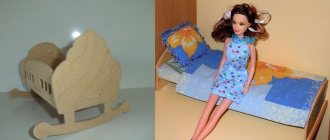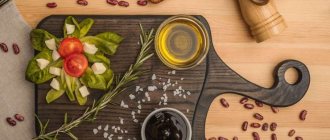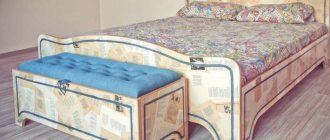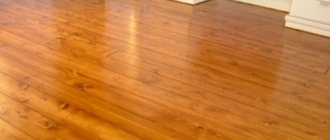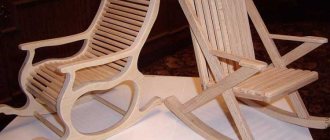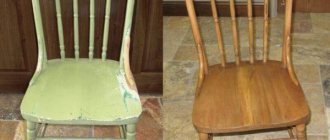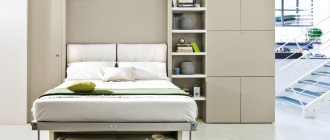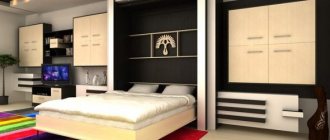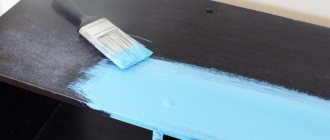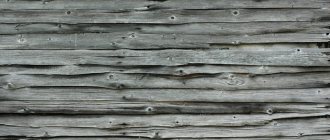Articles
All photos from the article
One of the most important kitchen utensils is cutting boards. It is on them that cutting vegetables, cutting meat and many other tasks are performed that allow you to prepare delicious dishes. Next, we will get acquainted with the characteristic features of plywood models, and also learn how to make them ourselves.
Photo of a plywood cutting board
Functionality of plywood in everyday life
Cutting boards can be divided into decorative and household. The decorative option is used to decorate the kitchen interior, so the type of material matters. Craftsmen use mainly high-quality wood species.
Boards for household needs are less demanding. The only condition is that the material is environmentally friendly. Taking into account the requirements, plywood products are a universal option that will satisfy any housewife.
The functionality of plywood in domestic conditions is determined by the following points:
- Does not deform under the influence of temperature fluctuations.
- Durable surface.
- Small mass.
- Plywood can be used for cutting, beating meat, and serving as a stand for hot dishes.
- Difficult to bend or break.
A self-made plywood cutting board can replace expensive wooden, ceramic, non-eco-friendly plastic and fragile glass kitchen utensils with this functionality.
Pros and cons of the material
On sale you can find many planks made of wood, which act as a decorative element in the kitchen and dining room. Practical housewives opt for boards on which they can cut meat products, cut vegetables, or use them as a stand for ready-made dishes. Handmade kitchen utensils are often decorated with decorative carvings or designs on one side, while the other side serves as a work surface. Even novice carpentry enthusiasts can make a cutting surface without much difficulty.
On solid wood cutting surfaces, it is recommended to cut only foods with minimal moisture content: baked goods, dried vegetables and fruits. The fact is that oak, beech and pine surfaces quickly collapse under the influence of moisture.
Advantages of wooden cutting surfaces:
- Large selection of shapes, sizes, colors;
- Environmental friendliness of the material;
- Increased antibacterial properties;
- Wide price range.
Cons of wooden kitchen cutting boards:
- In terms of weight, wooden planks are much heavier than their plastic counterparts;
- You need to wash it with a special product. You cannot use regular dishwashing gel;
- Cannot be washed in dishwashers;
- Prolonged exposure to water damages the wooden surface.
Features of manufacturing work
Housewives want the cutting board to not only perform direct functions, but also decorate the room. When making a product from plywood, it is worth considering that the surface of this material cannot be decorated with carvings. It is worth using other types of decoration.
The aesthetic appearance is achieved through unique contour lines and decorative patterns that are applied to the surface of the board. To make the board beautiful and original, you should pay special attention to the shape.
There are two ways to make plywood boards: solid and glued. Each option has its advantages over the other. A solid board is easier to make, while a glued board is more functional. When starting work, you should adequately assess your skills and capabilities.
Advantages of end products
An end plate is used for cutting meat products. On such a surface you can easily cut a piece of meat for a chop or entrecote. Oak end boards withstand high stress when struck with a hammer.
What is the difference between an end cutting surface? In it, the wood fibers are not arranged parallel, as is often the case in cutting boards, but perpendicular to the working plane. Professional chefs prefer to use end boards. The reasons for this choice are obvious:
- The working surface is much stronger and can withstand intense loads.
- End options are less susceptible to bacterial growth.
- Knives dull much more slowly, since the wood fibers in the board are perpendicular to the cut, and the knife blade seems to push them apart. In ordinary planks, the fibers are cut by a knife, which contributes to premature and rapid failure of the sharp blade.
Tools for work
To make a plywood board quickly and efficiently, you need to use the appropriate tools. If the work on making a kitchen product is being done for the first time, questions may arise regarding tools.
To make the simplest board you will need the following tools:
- If you think about how to cut plywood, then the ideal option would be a manual or electric jigsaw.
- To form the holes you will need a drill with a set of wood drill bits.
- A set of sandpaper with different degrees of grain.
- Sander.
- Milling machine.
- Rasp.
The set of tools for decorative finishing depends on how and with what the product will be decorated.
Basic Rules
The service life of your craft will depend on the quality of the wood you choose. We immediately refuse budgetary, but too soft pine - for the board we need a denser and more moisture-resistant solid that will not warp from constant washing, and will not be afraid of a knife. The best way to cope with this task is:
- Oak;
- Beech;
- Acacia;
- Pear;
- Cherry.
The shape of the board can be very different, as well as the size, but in any case it should be convenient to work with a certain type of product. The method of storing homemade utensils is also worth thinking about right away. And if you, for example, plan to hang it on a hook, then you will need to provide a fairly large hole somewhere on the edge or on the handle.
When making a board with a handle, make sure that its axis exactly coincides with the center line of the main blade. Otherwise, holding a bulky object will be difficult and inconvenient.
Cutting board mockups
Drawings of plywood cutting boards are very easy to make; just select the paper of the required format, a ruler and a simple pencil. The drawing is created in accordance with the following requirements:
- You need to decide on the shape of the future product.
- Consider the dimensions of the cutting board.
- Create a sketch of the product on paper.
- Using a ruler and other drawing tools, a layout is created.
The drawing recreates marks regarding the dimensions and other features of the future product.
How to make your own plywood cutting boards
A do-it-yourself plywood cutting board is made exclusively from material that is at least 10 millimeters thick. Otherwise, the product will turn out fragile. Next, exclusively mechanical actions are performed regarding the wooden material.
Algorithm for making kitchen boards from plywood:
- A sketch of the future product is transferred to a plywood board. In the process of transferring the drawing, a ruler can be used. You can cut out a design and trace it on plywood.
- Cut out the future product along the contour. Straight lines are formed using a circular saw, complex shapes are formed with a jigsaw.
- The edges of the contour cuts are sanded using sandpaper, a grinder or a file. The tool is selected according to the shape of the cut.
- A hole is drilled in the handle and the working surface is sanded.
- Decorative decoration depends on further functionality.
- The product must be impregnated with a protective composition, which will extend its service life.
Making boards using the gluing method has a slightly different algorithm: parts are cut out, each individual part is polished, the elements are processed, and combined into a single composition.
The business is only a penny, but the pleasure is a whole carload.
Classification
The main parameter that characterizes a sheet of plywood is its quality, determined by the number of knots per square meter of area.
There are five types of quality, designated by Roman numerals:
- IV - the lowest quality, which allows even falling knots and uneven edges of more than 5 mm. Such plywood is obviously not suitable for making a cutting board.
- III – such plywood has no more than 9 defects, the most noticeable of which are knots with a diameter of up to 6 mm. Plywood of this quality is also not suitable for kitchen boards.
- II - here there are only cracks, but no more than 20 cm, a new indicator is also introduced - glue leakage over an area of no more than 2% of the total sheet area. If you consider that the board itself is exactly the same length and will be about 20 cm, then, of course, quality II is also best avoided.
- I – quality I allows knots, but not more than 2 cm. If we take into account that knots differ from knots, sometimes these “interferences,” on the contrary, can add their own flavor to the board, then such plywood can already be considered as the source material.
- E is the so-called elite quality, there are no knots, and hence the direct path to work.
Oddly enough, but a reasonable number of knots for cutting boards is more of a plus than a minus
There are several more criteria for classifying plywood, but they will no longer be so critical when choosing. For example, sheet size in width and height. But the minimum size is 1525 by 1525 mm, which guarantees that you can get at least 10 boards from one sheet, for yourself, as well as for friends and acquaintances.
For our purposes, only one more parameter will be significant - the thickness of the plywood and, accordingly, the future product. Many people start with 6 mm and are quite satisfied, although, one way or another, over time they come to the conclusion that 10 mm would be better. This choice should be the most optimal.
Helpful advice: Among the parameters for classifying plywood, one of the most noticeable is its water resistance.
You must understand that the higher the water resistance, the more special adhesives the plywood contains. Hence the conclusion, no matter what sanitary safety certificate a sheet of plywood has, you should not use it if it is advertised as being extremely inaccessible to moisture. For kitchen purposes, it is better to follow the path , the simpler the better.
But laminated plywood is unlikely to be suitable for making a cutting board, but this is essentially the only limitation
Optimal shapes for convenient use
The shapes of cutting boards are responsible for convenience and functionality. The best options are rectangular, oval and round shapes. These are standard solutions for this type of product.
A DIY plywood cutting board should be not only beautiful, but also comfortable. Modern design solutions for kitchen utensils take into account all the functional features of the product.
Sliding models are current. The board slides apart, releasing the pallet. You can throw vegetable waste into the container so that it does not interfere with the cutting process. An analogue is boards with a waste compartment. Technologically, it looks like a drawer in a desk. The shape of such products should be rectangular.
Detailed analysis with video
We have briefly described the key steps in creating mosaic boards. Of course, in reality the process of making them looks much more complicated and involves quite a lot of intermediate work. Also, we think it’s clear that this is not a project for a balcony, but at least for an entry-level carpentry project, which includes a sawing machine, thickness planer and jointer.
You can watch a detailed analysis of the technology in this video. Here we show in detail how the process of making an end board with a container in which it is convenient to put chopped products takes place.
Finishing cutting boards
Beautiful cutting boards made of plywood are obtained as a result of decorative finishing. Due to the characteristics of the material, such an option as carving on plywood is completely excluded. At the same time, there are enough decorative options that will improve the aesthetics of the product.
A functional option remains to burn a design onto the surface of the product. The board, thanks to this design technique, can be used for its intended purpose or be purely decorative.
You can paint a wooden canvas. A product with such a pattern will serve solely as decoration. Making simple indentations along the edge can decorate the surface of the board no less effectively.
To protect the product from rapid wear and provide uniform color, the board is coated with mineral oils. They are completely harmless to health and have a good effect on the wooden base.
Not all boards from the store can provide sufficient hygiene and ease of use. A cutting board made by yourself will not only meet the needs of the person using it, but will also bring a unique flavor to the interior of the kitchen. Knowledge of the basic specifics of the technology will greatly simplify the work on the selected material.
Not all boards from the store can provide sufficient hygiene and ease of use. A cutting board made by yourself will not only meet the needs of the person using it, but will also bring a unique flavor to the interior of the kitchen. Knowledge of the basic specifics of the technology will greatly simplify the work on the selected material.
Basic Steps
Decoupage technology is not complicated and consists of several basic steps:
- sanding the surface of the product;
- primer;
- painting with white acrylic paint;
- drawing an image;
- varnish coating;
- sanding layers of varnish after it has dried.
Note! The best DIY decor ideas - interesting home decoration options. 165 photos of the best solutions
Plywood cutting board
Plywood is a lightweight material, it does not deform under high temperatures, is durable and easy to use. For a household cutting board, you should not choose a moisture-resistant one, as it is impregnated with synthetic resins.
When creating a board, to be able to grip it, you should get a comfortable shaped handle or make a special slot.
Manufacturing Guide
The following materials are useful for making plywood products:
- drill;
- jigsaw;
- grinder;
- rasp;
- milling machine.
The main work in the manufacture of plywood boards is carried out with a jigsaw. The cut along the marked contours must be done with a smooth and continuous stroke of the tool for subsequent quick processing of the ends.
Unlike wooden boards, decorative carvings are not made on plywood. The original design is achieved through the contour lines of the product, so the shape should be thought out and drawn on the sheet in advance.
Upon completion of cutting:
- sand the product;
- get rid of chips and irregularities using a rasp and sandpaper;
- remove chips and refine the ends with a milling machine.
Finally, the product should be finally sanded with fine-grained sandpaper, the non-working surface should be coated with varnish, and the working side and ends should be rubbed with wax.
In order to cut a hole in the board, you need to trace its outline, drill a spot and, inserting a jigsaw into it, make a saw according to the marked markings.
Important selection criteria
When choosing an end cutting board, you should listen to the following recommendations:
- To determine the required width of the board, you need to at least roughly understand its place in the kitchen. It would be ideal if the product does not need to be put away in a far corner every time. Also, the dimensions of the product should be selected based on what products you plan to cut. For meat lovers, a wide and heavy item is suitable.
- A wide board cannot be thin, otherwise it risks breaking under intense impact, since wood has practically no flexible properties.
- The board cannot be light in weight, otherwise it is possible that the thing is not made of solid wood. Weight less than 1 kg should alert you.
- It is necessary to choose products only from hard wood. The product certificate will help verify this. The absence or refusal of the seller to provide it indicates a low-quality handicraft item, not made using technology.
- Choosing the shape of your kitchen end board is a matter of taste. But it is much more convenient to use square or rectangular objects. A round board placed on its edge will constantly strive to roll away.
- It is necessary to inspect the product for the presence of resin on it. This indicates the use of coniferous trees, because, for example, oak does not emit this substance. Tree sap is very sticky, difficult to remove, and can start oozing out again at any time.
- A visual inspection will also reveal cracks in the wood. Their presence means impaired strength properties. Where there is one crack, others will appear, and if accidentally dropped, the board will split.
- You can choose any pattern on the product; here the product range is limited only by the imagination of the craftsman.
READ MORE: DIY tool box according to drawings
An end board is a great gift for someone who is interested in cooking. In addition to its excellent performance properties, it will decorate the kitchen. The noble color and impressive dimensions will show the wealth and good taste of the owner.
From a cut tree
A cutting board made from sawn wood can be used both for chopping meat (large) and for various slicing and shredding (small).
Materials for work:
- suitable tree cutting;
- wire brush with stiff bristles;
- sandpaper;
- mineral oil.
| Step No. | Image |
| 1. Using a stiff brush, clean the side of the cut from residual debris, small pieces of bark and moss. All this should not get into the food being prepared and products cut on the board. If the cut is taken uncleaned, when brushing, part of the bark will fall off. This is normal, and during further use of the product, particles of dry bark will not get into the food. | |
| 2. After cleaning the side, it is necessary to level and refine the working parts of the product. The easiest way to do this is with a grinder, walking several times along the flat sides of the cut. If you don’t have a sander, you can use sandpaper. To begin with, you should sand with coarse sandpaper, then go over the wood with a final sanding paper with a grain size of 150-180 microns. | |
| 3. After cleaning, the cut surface must be cleaned of fine dust. Then treat flat surfaces with mineral oil. This is necessary to protect the finished product from moisture and cracking. The oil is applied in layers. Before applying the next layer, the previous one must be allowed to absorb. The softer the wood of the product, the more oil will be required for impregnation. | |
| 4. As the oil layers dry, the surface will become stained. To even out the tone in less saturated areas, you need to add more oil. | |
| 5. The workpiece must be allowed to dry completely within 24 hours. | |
| 6. After 24 hours, the workpiece should be rubbed with a soft, dry cloth, and the cutting board will be ready for use. |
Frequent defects
Self-respecting craftsmen will not sell defective goods, but in the service market you can also find unscrupulous manufacturers. Buyers should carefully inspect the product for defects. Any seemingly insignificant flaw can shorten the life of a thing:
- The heterogeneous structure inside one solid bar appears in the form of white stripes. Most likely, this tree was exposed to severe frost, which will affect its strength, since its properties are impaired.
- If dark spots are visible on the surface of the wood, this indicates that the wood being used is rotten. A little time will pass and the damaged block will turn into dust.
- Poorly glued bars may come apart. A carelessly applied substance will ruin the entire appearance of the product.
- Even slight warping of the working surface of the product is unacceptable. Most likely it was stored in conditions of high humidity.
- The top side of the end board must be sanded smooth, otherwise the user will end up with a splinter. Minor roughness on the back surface is allowed and is not considered a defect.
- If different types of trees are used in production, you need to make sure that they are all hard varieties. If the buyer cannot visually determine it, he has the right to request a certificate. Using wood species of different hardness will lead to destruction of the product.
Interesting articles:
- Wooden floor in an apartment: do-it-yourself renovation
- Unedged board fence - instructions, photos and price
- Large-flowered chrysanthemums 44 photos, growing from seeds, garden varieties of Indian chrysanthemum and other types, use of gibberellin
- Lining dimensions standard width and thickness - table products 16 mm thick and 6 meters long standard board length
From the table top
A durable and functional cutting board can be made from an old countertop. If the size of the canvas is large enough, you can get a cutting kit. For manufacturing you may need the following materials:
- saw or jigsaw;
- sandpaper;
- mineral oil.
Manufacturing instructions:
- Think over the design of the product and draw or print it on a printer. Trace the contours of the board on the workpiece.
- Use a saw (if the board is rectangular) or a jigsaw (if the shape is arbitrary) to cut out the product. Sand the sides with sandpaper or a rasp.
- Cut or drill a hole for hanging. Sand the inside surface of the hole.
- Treat the sides with mineral oil to protect against moisture.
- Decorate the product by painting, cutting or burning.
The tabletop fragment selected for manufacturing must be intact, without chips, cracks or loose areas.
A simple option for beginners
To work, you will need an edged board with a thickness of at least 20 mm. Here it is better not to skimp and choose the best type of wood - Extra or class A, that is, without knots and wormholes. The tools are standard for DIY woodworking: jigsaw, drill, sander, chisel, yew, as well as a pencil and tape measure.
Work order:
- Cut out a template from paper - it is best to draw it on a piece of paper folded in half to achieve precise symmetry.
- Using the pattern, make markings on the prepared solid board.
- Using a jigsaw, cut the workpiece along the contour. If you have a complex sketch that includes arcs of small radius, it is better to cut through these areas using a metal file - it gives a more accurate line.
- The board blank must be thoroughly sanded using wheels of different grain sizes. Be sure to chamfer and sand all corners.
- Treat the finished product with Vaseline oil, allowing it to absorb well and dry, repeating this operation several times. By the way, you shouldn’t chase super-expensive mineral oil “especially for boards.” This is the same liquid that is sold in any pharmacy, just named differently.
- When the oil begins to appear on the surface, it should be removed with a dry rag and the board should be left for a day until completely dry.
Cutting board decoupage ideas
To decorate cutting boards made by yourself, the decoupage technique is most often used. This is applying a paper applique to a workpiece and coating it with varnish. This technique does not require much money or time, and the result looks very impressive.
Before working using the decoupage technique, the surface of the craft should be wiped with a degreasing solution and sanded well.
The most popular ideas for similar design of cutting boards:
- floral theme - if there are a lot of flowers in the kitchen interior or the hostess just likes this theme;
- New Year's theme - suitable for gifts to family and friends, as well as colleagues;
- vegetables and fruits - this theme will fit perfectly into the interior of any kitchen;
- Various images of food are the most suitable theme for decorating the kitchen space.
There is no need to rush to decoupage a cutting board; first you should look at examples of crafts, study master classes and then start doing the work.
Wooden cutting boards often absorb various odors, and bacteria accumulate on the cut surface. To prevent this from happening, you need to treat with mineral oil at least 3 times a year. Then the service life of the product will increase significantly.
join the discussion
Share with your friends
A cutting board is an important attribute in the kitchen of every housewife. It would seem that choosing a board is not difficult, but when it comes to purchasing, everything is not so simple: the models presented on the market may not fit into the interior, or the dimensions are too large (small), or the material does not inspire confidence.
Plastic boards are very popular due to their variety of colors and attractive prices, but recently there has been talk about the dangers of plastic when in contact with food, and this confuses many . Of course, no one has any questions about natural materials, but it is not always possible to find just such a board that would meet all the housewife’s requirements. There is a way out - make a cutting board with your own hands! All you need to do is stock up on wood, the necessary drawings and some knowledge, and your kitchen will have a magnificent homemade board!
More ideas
For boards, you can use driftwood and unusual pieces of wood. Sometimes clear shapes are avoided; they make do with grinding and impregnation of the product with protective oil.
You can cut a hole in the finished board to remove scraps, sand the cut, attach legs to the board, etc.
Wooden boards absorb odors and accumulate bacteria. To prevent this from happening, you should grind and saturate the product with oil at least 3 times a year. The service life of the board will increase.
READ MORE: How to connect the antenna cable to each other
